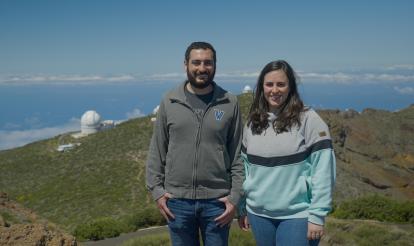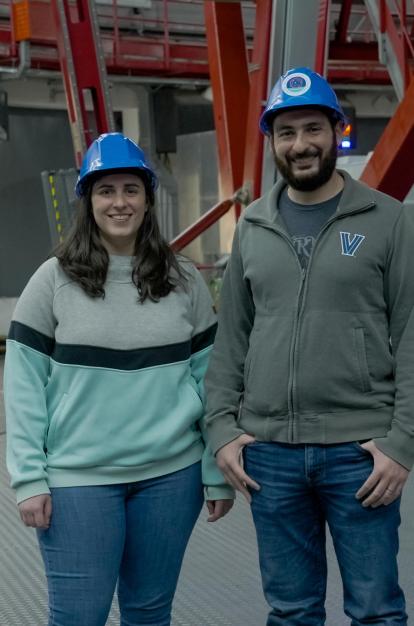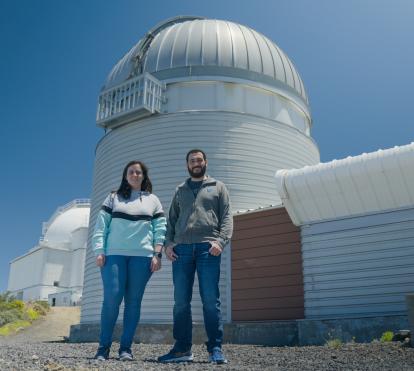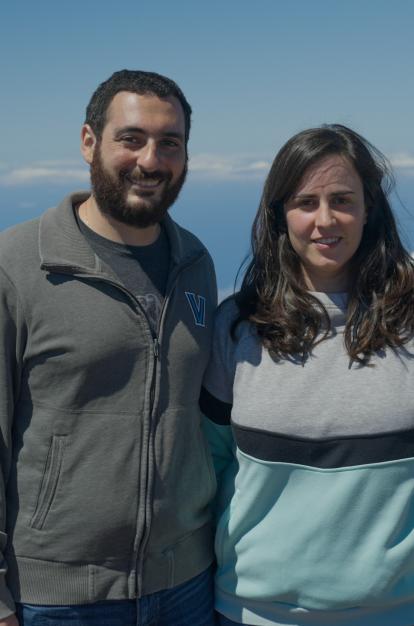
You are reading:

You are reading:

09.07.24
9 minutes readSend your questions to:
PhD in Astronomy and Astrophysics from the KU Leuven and postdoctoral researcher at the Instituto de Astrofísica de Canarias
Request interviewPhD in Astrophysics from the KU Leuven and postdoctoral researcher at the Instituto de Astrofísica de Canarias
Ana Escorza and Michael Abdul-Masih analyse stars at the Instituto de Astrofísica de Canarias. They met in Belgium, got married in Chile and now, thanks to the ”la Caixa” Foundation’s Postdoctoral Junior Leader fellowships, are working in Spain to help us better understand the universe. Using information from the telescopes on La Palma, they study the composition of these stars and how they interact.
The Roque de los Muchachos Observatory on La Palma is reached by a road full of bends and steep slopes. This is what it takes to climb from sea level to 2,400 metres in less than an hour. Having such a high altitude on an island with no major obstacles in the vicinity has allowed one of the most important astronomical research institutions in the world to develop in the Canary Islands. Once you have risen above the sea of clouds and reached the summit of the island of La Palma, around twenty telescopes are scattered across a spectacular landscape. They are not clustered together, and you have to go by car to get from one to the other. The observatory covers almost 200 hectares, which Ana Escorza describes as a kind of huge campsite, with telescopes instead of huts or tents.
Ana is a physicist. She was born in La Rioja and, after spending a few years doing research in Belgium and Chile, she has returned to Spain to work at the Instituto de Astrofísica de Canarias (IAC). “I study stars like the Sun, but older, and what I analyse is that these stars produce many of the chemical elements that surround us: the iron in our blood, the oxygen we breathe... Practically everything that surrounds us was made inside the stars,” she explains. In addition to this study from a chemical perspective, she is also investigating how pairs of stars that are connected interact with each other.
Alongside her is Michael Abdul-Masih, an American astrophysicist who, like his colleague, worked at centres in Belgium and Chile before settling at the IAC. But their research goals are different. “I also study stars, but they’re much heavier and hotter than Ana’s: at least eight times heavier than the Sun,” he says. He adds that he focuses on binary stars, those pairs of twin stars, also described by Escorza, that are very close to each other. “They look like peanuts,” Abdul-Masih illustrates, explaining his interest in better understanding “the physics that happens” when these pairs exchange material. “There’s a lot going on at the same time and we need to understand more about the interaction between the stars,” he adds.


Ana and Michael have pursued parallel careers, and not by chance. In addition to their passion for astrophysics, they share their personal lives as a couple. They met when they were both studying for their PhDs in Belgium and, from there, went on to work together at the European Southern Observatory, which, despite its name, is located in Chile. There, they got married, and after some time, they both applied for the fellowships that have brought them to the Canary Islands. They consider themselves very fortunate to have been able to combine their careers in this way, as it is not common for research couples to do so.

The fellowships they are working with at the IAC are those of the postdoctoral Junior Leader programme, an initiative with which the ”la Caixa” Foundation seeks to support excellent researchers who wish to continue their research careers in Spain and Portugal in STEM areas. Ana and Michael are not the only scientists funded by the Foundation to work at this Canary Islands institution. Three of their colleagues are developing their research projects here through the doctoral INPhINIT programme: the Brazilian João Pedro Benedetti, who is studying the ultraviolet spectra of galaxies; the Austrian Desmond Grossmann, who is modelling red giant stars in the far reaches of the Milky Way; and the Bulgarian Atanas Stefanov, who is developing astrophysical tools that can be used with various data sources.
For Ana, this fellowship has given her the chance to “return to Spain”. She left in 2013 and, after a decade of research abroad, she says: “I wanted to try working here and it was a very good opportunity.” She also values the independence the programme gives them, something Michael emphasises: “We’ve gone from being part of a team to being principal investigators. Now we can do our own science without a boss telling us what to do. We can choose what we research.”
An independence that does not mean isolation. For Michael, who has lived in several countries, the main difference he has found between conducting research in Spain and in those other places is “teamwork”. “Collaboration is very strong in Europe and especially in Spain. That’s something difficult to find elsewhere,” he reflects. Ana agrees: “There are 250 astronomers at the institute. You go for a coffee feeling a bit down because your day hasn’t gone well, you sit down to talk to someone and creativity is born in the cafeteria. There are so many people with so many different specialisations that science flows between the tiles.” But not everything is positive when comparing the way science works in our country with that of other places: “There’s still a little lack of appreciation for researchers in Spain. There’s not as much money as in northern Europe, and for Spanish science to be truly competitive we need a slightly stronger financial push,” suggests the physicist from La Rioja.
The scientists share these reflections from within the Mercator telescope, one of the twenty installations that make up the La Palma observatory. In its dome, a large opening allows us to look out into the universe. And on the ground floor, a room full of screens is used to control the instruments and analyse the data obtained. Next door is a living room with a kitchen and a bathroom, allowing researchers to spend entire nights there doing research. Ana and Michael’s daily work is not done here, but at the IAC offices on the neighbouring island of Tenerife. There they analyse the data obtained by the Mercator, which is an old acquaintance for them. During their PhD studies in Belgium, they often came to this Canary Island to spend the nights observing the sky from this telescope, and they hope to do so again in the coming months, when they need specific data that cannot be obtained remotely.
Ana describes these observation stays as days “from dawn to dusk, but in reverse”: they start working around sunset and finish when the sun rises. This rhythm is so common here that the observatory’s residence, which provides room and board for the scientists who come to conduct their research in this remote corner so far from the cities, has a wing for those who have to work at night and sleep during the day, ensuring that nothing disturbs their slumber in the mornings.
In addition to the beauty of its surroundings, the location has some characteristics that are ideal for observing the stars: among other things, its altitude – being above the clouds avoids them interfering with the observation and the problems of humidity – and a quality of sky that is even protected by law. This is what has made it possible to develop the Instituto de Astrofísica de Canarias, which, in addition to the observatory on La Palma, has another on Mount Teide, in Tenerife. Ana explains that there is no similar infrastructure in Europe and that it is among the top three in the world. In fact, a few kilometres from the Mercator is the Gran Telescopio Canarias, the largest optical telescope in the world. Entering it and looking into its 10-metre diameter mirror is awe-inspiring. The 36 hexagonal pieces that make it up collect the light that arrives from the stars and send it to the instruments that process the data.

If Ana and Michael chose to move to these islands to work, it was because of the IAC’s cutting-edge nature. Also because of its size: as a couple, it suits them to be in such a large institution, to be able to do research, as she says, “together, but not in each other’s pockets”: in the same place, but each working on their own project and with their own collaborators. How do you manage this overlap between personal and professional life? “It’s inevitable that if you’re at home with someone who knows about similar things to you, you ask them things and you help each other. So, yes, we’ve worked together on some things. But it’s also true that Michael would like to talk about science 24 hours a day and sometimes I need to disconnect and have to tell him: ‘Not now’,” admits Ana. “My brain is always working. she needs a break from time to time to think about other things, and I think it’s good for my health,” Michael recognises.

Talking to them, their passion for their work is evident. They appreciate the importance of research for its own sake, beyond its possible practical uses. “A very important part of science is simply dedicated to better understanding the world and the universe, perhaps without directly seeking a day-to-day application,” reflects Ana, but she also defends the impact of this knowledge on our daily lives: “Astrophysics has contributed a lot to technological development. The camera you have in your mobile phone is much better than one from 15 years ago. Flash drives used to hold almost nothing but can now store terabytes. That development of things that fit into our pockets is driven by sciences like astrophysics, because we need to put much smaller technology into missions to launch it into space or to make compact telescopes like this one.”
Michael gives other examples, such as the GPS in our cars and phones, which would not be so precise without the knowledge that physics provides, and even energy: “Stars are nuclear reactors. If we understand better what goes on inside them, we can use that to make new energies here.”
From the highest point of La Palma, thousands of kilometres from his birthplace, this American scientist sums up the depth of the research which he and his partner conduct using these telescopes to generate knowledge: “We’re studying the most extreme physics in the universe.”